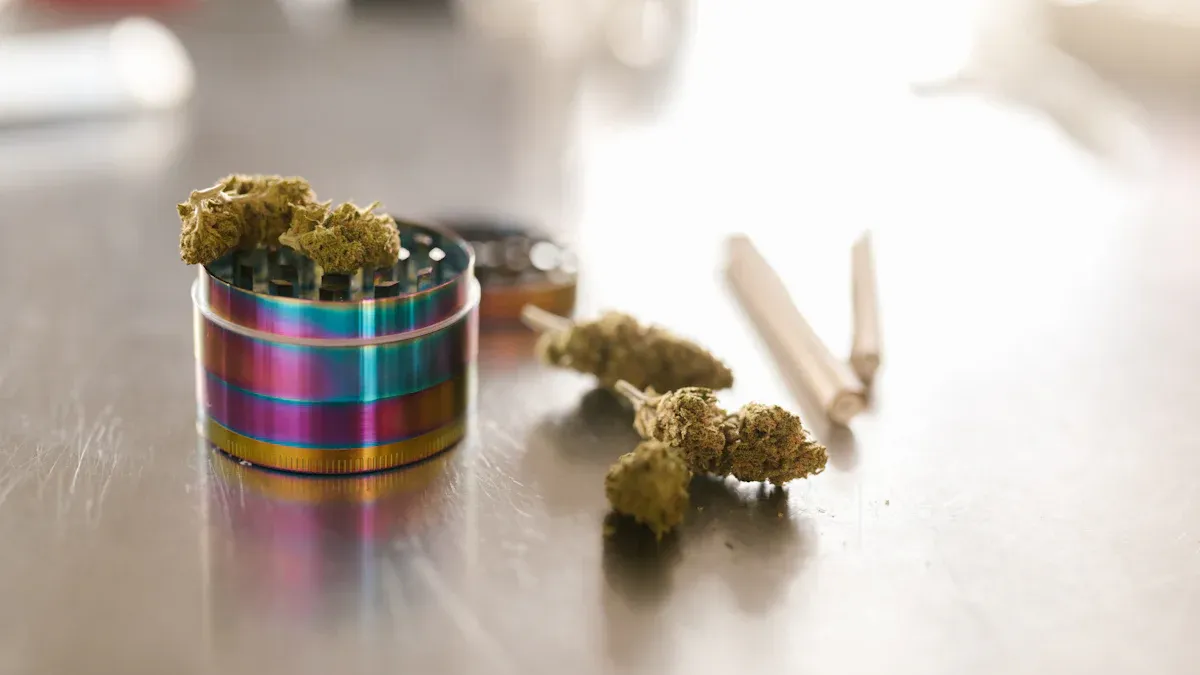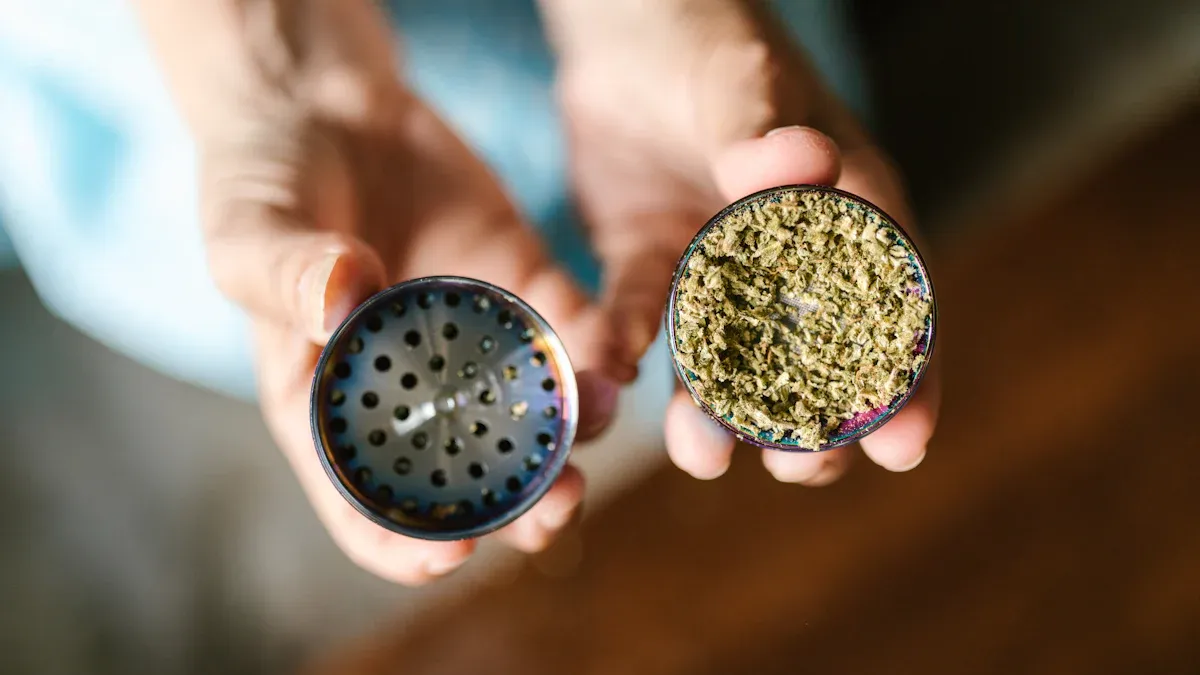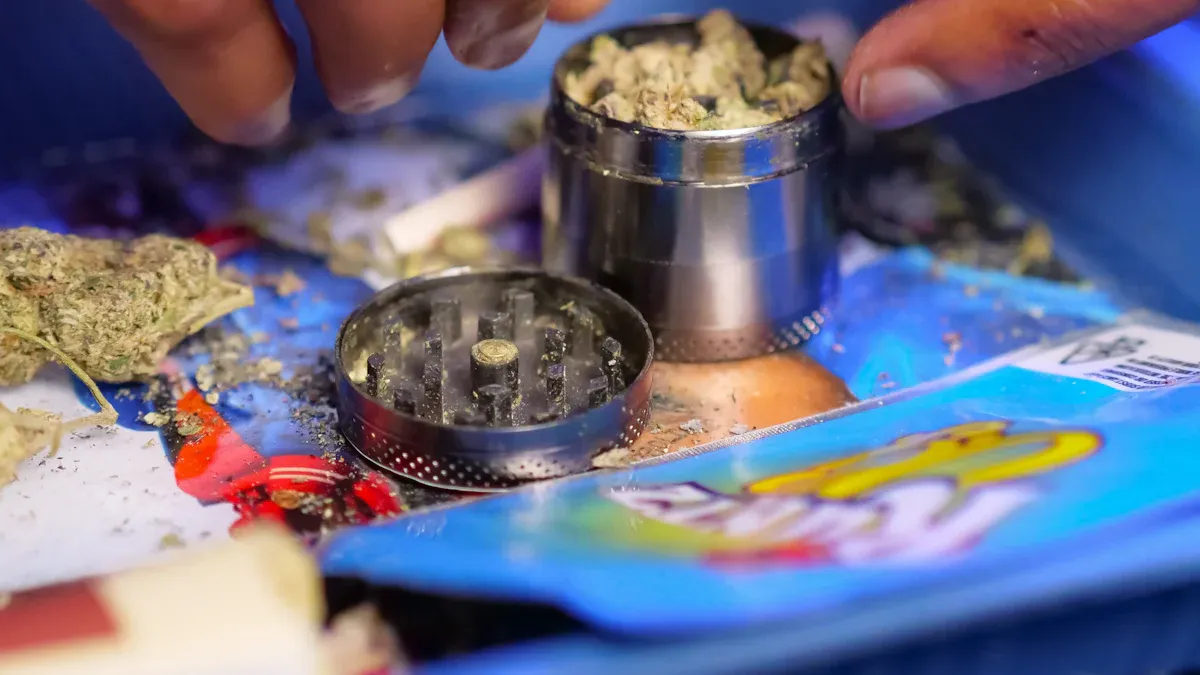
Have you ever struggled to prepare herbs for cooking, tea, or other uses? That’s where an herb grinder can make your life easier. This handy tool helps you break down herbs into smaller, more manageable pieces. It’s not just about convenience—it’s about efficiency too.
For example:
- People with arthritis love how it reduces the need for finger strength.
- It minimizes waste by grinding herbs evenly, so nothing goes unused.
- Electric grinders, like the Mamba, save time with their rapid, one-handed operation.
Whether you’re cooking or crafting, an herb grinder simplifies the process and gets the job done faster.
Key Takeaways
- A grinder helps you crush herbs quickly for cooking or crafts.
- Clean your grinder often to keep it working well and your herbs tasty.
- Pick a grinder that fits your needs: hand-powered for control, electric for speed, or multi-chamber for more options.
- Don’t put too many herbs in the grinder to avoid uneven grinding or breaking it.
- Try different ways to grind herbs to improve their taste and smell.
How to Use an Herb Grinder

Step-by-Step Guide
Using an herb grinder is simple once you get the hang of it. Follow these steps to make the process smooth and efficient:
- Prepare your herb: Make sure your herb is dried and cured. Remove any stems, seeds, or other unwanted parts. This ensures a consistent grind and prevents clogging.
- Load the grinder: Open the grinder and place a small amount of herb in the grinding chamber. Avoid overloading it, as this can make grinding harder and less effective.
- Grind your herb: Close the grinder securely. Twist or turn the top and bottom sections in opposite directions. Apply gentle pressure, but don’t force it—let the grinder do the work.
- Collect and use the ground herb: Open the grinder and carefully remove the ground herb. Use it immediately for cooking, brewing tea, or other purposes. If you’re not using it right away, store it in an airtight container to preserve its freshness.
Pro Tip: If you’re using a multi-chamber grinder, check the bottom chamber for fine herb particles or kief. These can add extra flavor or potency to your recipes.
Tips for Best Results
To get the most out of your herb grinder, keep these tips in mind:
-
Don’t rush the process: Grinding too quickly can lead to uneven results. Take your time to ensure a consistent texture.
-
Choose the right grinding technique: Did you know that the way you grind can affect the quality of your herbs? For example, cryogenic grinding retains 29.5% more volatile oils compared to ambient grinding. Check out the comparison below:
Grinding Technique Volatile Oil Retention Notes Cryogenic Grinding 29.5% more Retains volatile compounds better than ambient grinding. Ambient Grinding 100% baseline Higher loss of essential oils (37% for nutmeg, 17% for cinnamon). -
Clean your grinder regularly: Residue buildup can affect performance and flavor. A clean grinder works more efficiently and lasts longer.
-
Experiment with different grinders: Manual grinders are great for control, while electric ones save time. Multi-chamber grinders let you collect fine particles for special uses. Try different types to see what works best for you.
Quick Reminder: Always store your grinder in a dry place to prevent rust or damage. A well-maintained grinder will serve you for years.
Types of Herb Grinders

Choosing the right herb grinder can make all the difference in your herb preparation experience. Whether you prefer manual control, electric convenience, or multi-chamber versatility, there’s a grinder out there for you. Let’s explore the options!
Manual Grinders
Manual grinders are perfect if you enjoy hands-on control over your grinding process. They’re simple, portable, and don’t rely on electricity, making them ideal for on-the-go use.
Here’s why manual grinders stand out:
- Precision and Control: You can adjust the grind size to suit your needs, ensuring the best flavor extraction.
- Enhanced Flavor and Aroma: Grinding herbs manually helps retain essential oils, giving you a richer taste and aroma.
- Portability and Versatility: Lightweight and compact, manual grinders are easy to carry for travel or outdoor activities.
- Environmentally Friendly Option: Since they don’t require electricity, they’re a sustainable choice.
Tip: If you’re new to grinding, start with a manual grinder to get a feel for the process. It’s a great way to learn how grind size affects your herbs.
Electric Grinders
Electric grinders are all about speed and convenience. They’re perfect for heavy users or anyone who wants to save time and effort.
| Benefit | Description |
|---|---|
| Efficiency | Quickly shreds large amounts of herbs, making it ideal for frequent users. |
| Reduces Mess | Minimizes mess compared to manual grinding, saving you cleanup time. |
| Hands-Free | Great for people with injuries or disabilities, as it reduces physical strain. |
| Consistency | Provides a uniform grind, though some users debate its reliability. |
Electric grinders are especially useful if you need to prepare herbs in bulk. They’re fast, efficient, and easy to use.
Note: When using an electric grinder, avoid overloading it. This ensures the motor runs smoothly and extends the grinder’s lifespan.
Multi-Chamber Grinders
Multi-chamber grinders take herb preparation to the next level. They’re designed to separate your herbs into different compartments, offering added functionality.
| Feature | Benefit |
|---|---|
| Even Grinding | Ensures all herb pieces are the same size for smoother results. |
| Kief Collection | Collects potent kief separately, which you can use for added flavor or potency. |
| Built-In Storage | Keeps ground herbs fresh and ready for use. |
These grinders are perfect for anyone who wants to maximize their herb’s potential. The kief collection feature is especially popular among users who enjoy experimenting with concentrated herb particles.
Pro Tip: If you’re using a multi-chamber grinder, check the bottom chamber regularly. You might find a treasure trove of fine herb particles waiting to enhance your recipes!
Maintenance Tips for Herb Grinders
Keeping your herb grinder in top shape doesn’t take much effort, but it makes a big difference. A well-maintained grinder works better, lasts longer, and keeps your herbs tasting fresh. Let’s dive into some easy maintenance tips.
Cleaning Tips
Cleaning your grinder regularly is the best way to keep it performing like new. Residue buildup can clog the grinder and affect the flavor of your herbs. Here’s how you can clean it:
- Disassemble the grinder: Take apart all the sections, including the grinding chamber and kief catcher (if it has one).
- Brush off residue: Use a small brush or toothbrush to remove leftover herb particles. Pay extra attention to the teeth and edges.
- Wash with warm water: Rinse the parts with warm water and mild soap. Avoid soaking if your grinder is made of wood or has electronic components.
- Dry thoroughly: Pat the pieces dry with a towel and let them air dry completely before reassembling.
Pro Tip: For stubborn residue, try using rubbing alcohol and a cotton swab. It’s great for breaking down sticky buildup.
Preventing Damage
A damaged grinder can ruin your herb preparation experience. Luckily, you can avoid most issues with a few simple precautions:
- Don’t overload: Overstuffing the grinder puts stress on the teeth and can cause them to break. Grind small amounts at a time for smoother results.
- Handle with care: Avoid dropping your grinder or forcing it to turn when it’s stuck. Gentle handling goes a long way in preventing wear and tear.
- Choose the right grinder: If you’re grinding tough herbs, use a sturdy grinder made of metal or high-quality plastic.
Quick Reminder: If you notice your grinder isn’t working as smoothly, check for loose parts or worn teeth. Fixing small issues early can prevent bigger problems later.
Proper Storage
Storing your herb grinder properly keeps it clean and ready for use. It also protects it from damage and extends its lifespan. Follow these tips for safe storage:
- Keep it dry: Moisture can cause rust or mold, especially if your grinder is made of metal. Store it in a dry place away from humidity.
- Use a case or pouch: If you travel with your grinder, keep it in a protective case to prevent scratches or dents.
- Avoid extreme temperatures: Don’t leave your grinder in direct sunlight or freezing conditions. Extreme heat or cold can warp the material.
Note: If you’re storing ground herbs inside the grinder, make sure it’s airtight to preserve freshness and flavor.
Common Mistakes to Avoid
Even the most experienced users can make mistakes when using an herb grinder. By knowing what to avoid, you can keep your grinder in great shape and get the best results every time.
Overloading the Grinder
It’s tempting to stuff as much herb as possible into the grinder to save time. But overloading it can lead to uneven grinding and even damage the teeth. When you cram too much in, the grinder struggles to rotate smoothly. This puts unnecessary stress on the parts and can shorten its lifespan.
Instead, grind in smaller batches. This ensures a consistent texture and keeps your grinder working efficiently. If you’re using an electric grinder, overloading can also strain the motor, leading to overheating or malfunctions.
Tip: If you notice resistance while grinding, stop and remove some of the herbs. It’s better to take your time than risk breaking your grinder.
Using the Wrong Grinder Type
Not all grinders are created equal. Using the wrong type for your needs can result in frustration and poor results. For example, manual grinders are great for small amounts of herb, but they may not handle tougher herbs as well as electric ones. On the other hand, electric grinders are fast but might not give you the control you need for a finer grind.
Multi-chamber grinders are perfect if you want to collect kief, but they might be overkill for casual use. Think about how you plan to use your grinder and choose the type that fits your needs.
Pro Tip: If you’re unsure which grinder to pick, start with a basic manual grinder. It’s a versatile option that works well for most beginners.
Neglecting Maintenance
Skipping regular maintenance is one of the quickest ways to ruin your herb grinder. Over time, residue builds up, making it harder to grind and affecting the flavor of your herbs. Neglect can also lead to mechanical issues like misalignment or surface wear.
Here’s a breakdown of what happens when you don’t maintain your grinder:
| Consequence of Neglect | Impact on Grinder | Evidence |
|---|---|---|
| Surface wear | Increased downtime | Up to 30% decrease in roller longevity |
| Misalignment | Reduced efficiency | 15% increase in energy consumption |
| Overheating | Higher repair costs | Direct impact on profitability and sustainability |
To avoid these issues, clean your grinder regularly and store it properly. A little care goes a long way in keeping it functional and efficient.
Quick Reminder: If your grinder starts feeling sticky or hard to turn, it’s time for a deep clean. Don’t wait until it’s completely clogged!
Using an herb grinder can completely transform how you prepare herbs. It saves time, ensures consistency, and even helps you unlock richer flavors and aromas. Whether you’re cooking, brewing tea, or crafting, this tool makes the process smoother and more enjoyable.
Now it’s your turn! Try out the tips we’ve shared and experiment with different grinder types. Start small, and you’ll quickly discover what works best for you. Who knows? You might even find a new favorite way to enjoy your herbs. 🌿
FAQ
How do I know if my herb grinder needs cleaning?
If your grinder feels sticky or hard to turn, it’s time for a clean. Residue buildup can clog the teeth and affect performance. Regular cleaning keeps it working smoothly and preserves the flavor of your herbs.
Tip: Clean your grinder after every few uses to avoid buildup.
Can I grind fresh herbs in my grinder?
Fresh herbs contain moisture, which can clog your grinder and lead to uneven results. Dry your herbs completely before grinding for the best texture and flavor.
Note: If you must grind fresh herbs, use a grinder designed for wet ingredients.
What’s the best grinder for beginners?
Manual grinders are great for beginners. They’re simple, affordable, and give you control over the grind size. Electric grinders are faster but may feel overwhelming at first.
Pro Tip: Start with a basic manual grinder to learn the process before upgrading.
Is kief safe to use in recipes?
Yes, kief is safe and adds extra flavor or potency to your recipes. It’s a concentrated form of herb particles collected in multi-chamber grinders.
Quick Reminder: Use kief sparingly—it’s potent and can overpower your dish if you’re not careful.
Can I travel with my herb grinder?
Absolutely! Choose a compact manual grinder for portability. Store it in a protective case to prevent damage during travel.
Alert: Check local laws if you’re traveling internationally. Some places restrict herb grinders.







